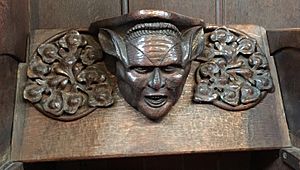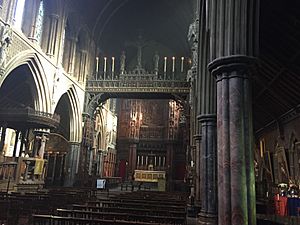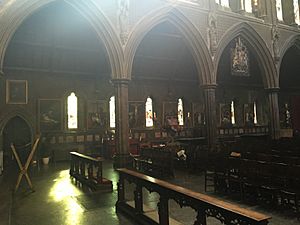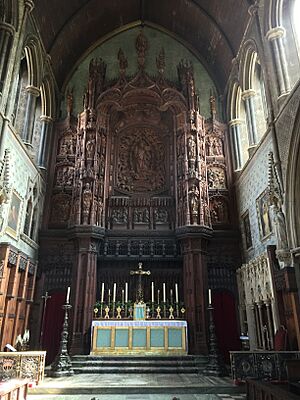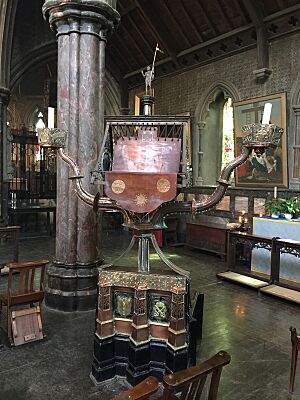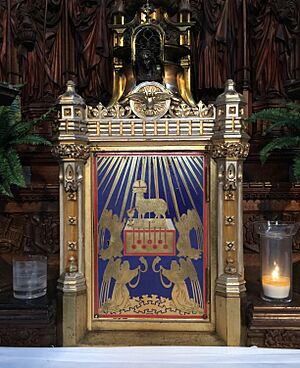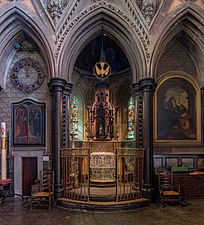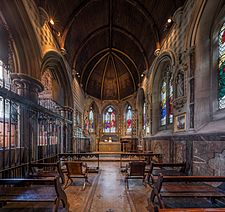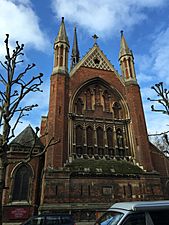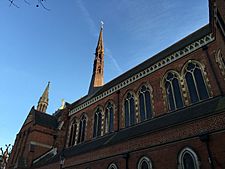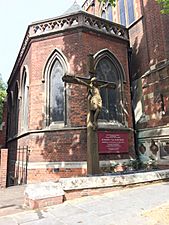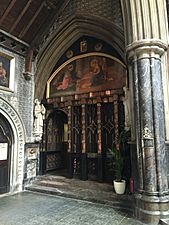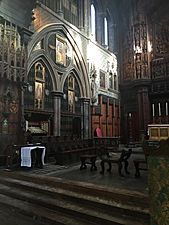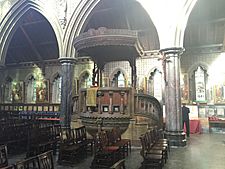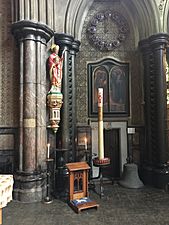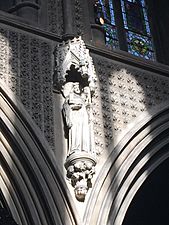St Cuthbert's, Earls Court facts for kids
Quick facts for kids St Cuthbert's Church, Earls Court |
|
|---|---|
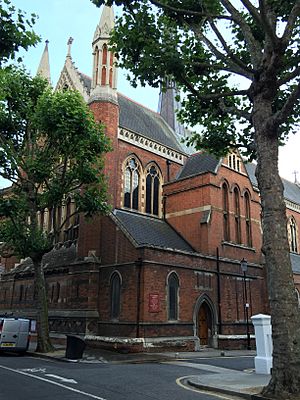 |
|
| Location | 50 Philbeach Gardens, Earls Court, London, SW5 |
| Country | United Kingdom |
| Denomination | Church of England |
| Churchmanship | Anglo-Catholic |
| History | |
| Founded | 1883 |
| Dedicated | 1884 |
| Architecture | |
| Heritage designation | Grade I |
| Architect(s) | Hugh Roumieu Gough |
| Style | Gothic Cistercian |
| Years built | 1884–87 |
| Administration | |
| Deanery | Chelsea |
| Archdeaconry | Middlesex |
| Diocese | London |
| Province | Canterbury |
St Cuthbert's Church in Earls Court, London, is a very special old church. It's so important that it's a 'Grade I listed' building, which means it's protected for its history and beauty.
It was built between 1884 and 1887 by an architect named Hugh Roumieu Gough. Many of the beautiful things inside were designed by William Bainbridge Reynolds, who was part of the church community. People call it a 'jewel' of the Arts and Crafts movement, a style popular in the late 1800s and early 1900s.
You can find St Cuthbert's in Earls Court, London. Next to it are the clergy house (where church leaders live) and Philbeach Hall. It's famous for its amazing inside decorations and its traditional way of worship.
Contents
Church History
St Cuthbert's is the most impressive church built in western Kensington. Its construction began in 1884 and finished in 1887. Over the next 30 years, it became even more beautiful.
The clergy house, where church leaders live, was built first in 1883. The church itself started in 1884. The foundation stone, a special block from Lindisfarne, was laid by Earl Beauchamp in July 1884.
Work stopped for a while because they needed more money. But by July 1887, the roof was being put on. The church was officially opened by Bishop Temple on November 18, 1887. It could seat about 950 people and cost around £11,000 to build.
A Famous Incident
St Cuthbert's quickly became a very popular church. On Good Friday in 1898, a well-known activist named John Kensit caused a stir. During the service, he grabbed a crucifix and shouted that he was against 'idolatry' in the Church of England.
Kensit and his friends were removed from the church. He was fined, but later won his appeal. This event actually made St Cuthbert's even more famous. There's even a carving of Kensit with donkey ears under the vicar's seat in the church!
Later Buildings and Repairs
The Philbeach Hall was built next to the church between 1894 and 1896. It had a library, a hall, a gym, and rooms for curates (assistant priests).
During the Second World War, the northern part of the hall was destroyed by a bomb in 1940. It was rebuilt later in 1956–57. The church also suffered damage in 1944 from a V-1 flying bomb. Its western bell tower was removed, and the roof was replaced with copper in 1946–48.
Church Design and Architecture
The architect, Gough, designed St Cuthbert's to be tall and simple, like old Cistercian monasteries. It has one main roof and gets light from a row of high windows.
The church has side aisles, except for a special chapel called the Lady Chapel. Below the church, there's a crypt that was meant for meeting rooms and a mortuary chapel.
Gough's design included a large, plain arch on the east wall. Inside, the walls were originally plain brick, waiting for decorations. Some beautiful features were added early on. These included the pulpit, a special stand for sermons, and the font, used for baptisms.
Inside Decorations
From 1887 to 1914, St Cuthbert's was constantly decorated and made more beautiful. Many artists and craftspeople, both professional and amateur, helped. Skilled artists like Bainbridge Reynolds and J. Harold Gibbons worked on bigger projects.
Church members also formed 'guilds' to help with decorations. They took classes in carving, metalwork, and embroidery. For example, the Guild of St Peter carved the stone patterns on the walls. The Guild of St Joseph made the choir stalls, and the Guild of St Margaret made the special church clothes.
The Rood Screen
Gough designed the rood screen in 1893. This is a screen that separates the main part of the church from the altar area. It features a figure of Christ.
The screen also has a small altar where special items are kept. An inscription in Latin from the Bible says: Verbum caro factum est et habitavit in nobis – "The Word was made flesh and dwelt among us."
The Reredos
The large reredos, a decorated screen behind the main altar, covers the entire eastern wall. It was designed by Reverend Ernest Geldart in 1899–1900. It shows "The Worship of the Incarnate Son of God with Incense and Lights." It was finally completed in 1913–14 when enough money was raised. During cleaning, glass from the 1944 bomb blast was found in it.
Works by Bainbridge Reynolds
William Bainbridge Reynolds added many wonderful things to St Cuthbert's:
- Screens between different parts of the church (around 1895–1904).
- The clock on the west wall (1898).
- The altar rail in the Lady Chapel.
- The Royal Arms (hanging in the south arcade) in 1904, as a memorial to Queen Victoria.
- The Paschal candlestick (1905).
- The High Altar with its silver front (1910).
- The Tabernacle, a special container, designed by J. Harold Gibbons and made by Reynolds (1933).
- The lectern, a stand for reading, which is very striking and has a unique "Nouveau Viking" style.
Other Artworks
- Stations of the Cross: These paintings showing events from Jesus's final journey were created by Franz Vinck in 1888.
- Statues: The statues above the pillars and the statue of St Gregory on the east wall were made by Gilbert Boulton of Cheltenham.
- Stained Glass: The Lady Chapel and baptistery once had beautiful stained glass windows by Charles Eamer Kempe. Many of these were destroyed in 1944 and replaced with new glass by Hugh Ray Easton between 1947 and 1960.
- Calvary: A memorial cross outside the east end of the church was designed by J. Harold Gibbons and built in 1919 to remember those lost in the First World War.
The Organ
The church has a large organ built by Robert Hunter in 1899–1900. It is housed in a special chamber added by Gough.
Decorations continued until 1914. The church garden is still looked after by a small group of church members today.
Gallery
Worship Style
St Cuthbert's follows a style of worship called Anglo-Catholicism. This means it practices the "Catholic faith as taught by the Church of England." It offers traditional services, with special music, choir, and sometimes incense.
The main services, called Masses, follow the Common Worship liturgy.
Church Leaders (Incumbents)
- 1883–1924: Henry Westall
- 1925–1936: Frederick Goldsworthy Croom
- 1936–1961: Charles Lewis Gage-Brown
- 1961–1969: Gerard Irvine
- 1969–2013: John Vine
- 2013–present: Paul Bagott
Service Times
- Sunday
- Morning Prayer at 09:30 am
- Family Mass at 10:00 am
- High Mass at 11:00 am
- Evensong & Benediction at 6:00 pm
- Tuesday to Friday
- Morning Prayer at 9:00 am
- Evening Prayer at 6:00 pm
- Low Mass at 6:30 pm (Tuesday & Thursday)
- Saturday
- Morning Prayer at 10:00 am
- Low Mass at 10:30 am
- Evening Prayer at 6:00 pm
- Weekday Solemnities (check church notices for times)


